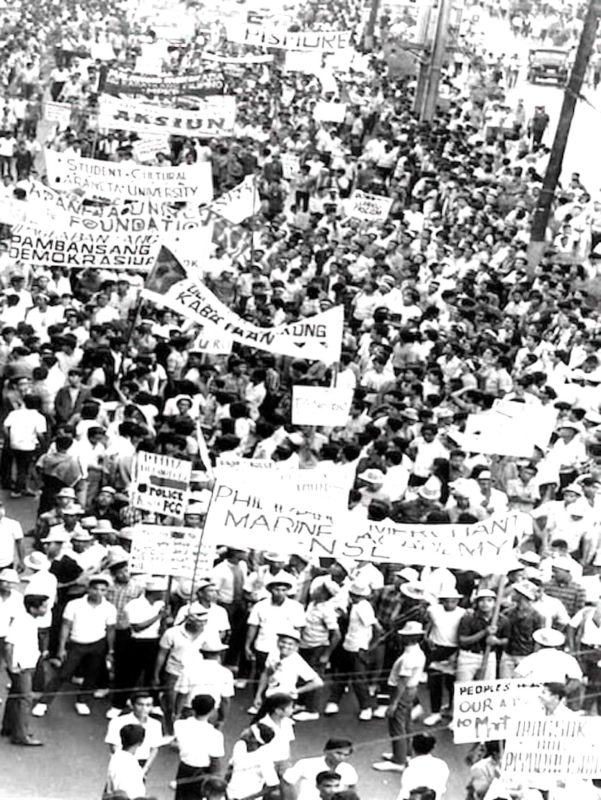1970s: From Plaza Miranda to Mendiola

A 1970s anti-government protest.
On January 26, 1970, students led by Atenista Edgar Jopson (1948-1982), president of the 70-member-student-orgs National Union of Students in the Philippines (NUSP), organized a huge rally with a permit granted by the Manila City Mayor Antonio Villegas.
At 5:30 p.m. of that same day, the young protesters scared President Marcos out of his wits. As Marcos was stepping down his way out of the Legislative Building, the mighty dictator felt the real sentiment of the enlightened youth. He witnessed how his evil-looking effigy was burned on Burgos Drive and also saw how the presidential security men protected him from the cardboard coffin hurled by unseen hands in his direction.
Mindful of the indignity he endured that day, he penned on his diary that very night:
“After the State of the Nation address… we were going down the front stairs, the bottles, placard handles, stones and other missiles started dropping all around us on the driveway to the tune of a ‘Marcos, Puppet’ chant…”
Marcos was far from being a benevolent dictator. Both pragmatic and strategic, Marcos seemed to have embraced the twin principle of “Power Is Might” and Arthur Desmond’s “Might Is Right” (1896). Those brute-force sounding principles of “Power Is Might” and “Might Is Right,” when intentionally interlocked and astutely utilized in an effort appear to extend the famous Darwinian evolutionary theory of “The Survival of the Fittest” in the contemporary period.
Marcos, like all dictators, rejected the conventional ideas such as the advocacy of human dignity and human rights, while he, like all dictators, argued till the end that only political strength and power can establish what is “morally right.” He felt no qualms in using lethal force as he sought to quell mass protests against him and his left brain was saying, it’s right and just.
The Marcosian theory was put into orthopraxis in Plaza Miranda, which, in the words of National Artist for Literature Nick Joaquin, is “the crossroads of the nation, the forum of the land.”
Open to criticism and transparent in governance, whenever any Juan or Juana de la Cruz questioned the government or any of its officials, Ramon Magsaysay was quoted as saying: “Can we defend this at Plaza Miranda?” For the People’s President, Magsaysay, Plaza Miranda was the country’s “Foremost Public Square,” the ultimate venue of intelligent public consultations that engaged everyone, even the lowest member of the Filipino society.
The shocking event of August 21, 1971, changed all that. The grenade bombing of Plaza Miranda in 1971 proved to be the most blatant assault on free speech, as it were free speech was shot in the head pointblank. The miting de avance of the Liberal Party, Plaza Miranda became ground zero of a massive explosion that caused nine deaths and injured 95 others, including the prominent political leaders who were on the stage.
As expected, the Filipino bishops condemned the 1971 bombing, describing it as brutal and premeditated. “The public crime perpetrated at Plaza Miranda,” the CBCP asserted, was “unprecedented in its cruelty and wicked machinations.”
It seems the Marcosian militarization was invented, according to American professor Dr. Robert Youngblood in his book Marcos Against the Church (1990), to cover up cronyism and nepotism that resulted in the gradual plunder of the people’s coffer.
Since then, the life of Juan and Juana de la Cruz became miserable, enduring, not just praying, the sorrow mysteries of the Holy Rosary. Under his rule, the common people and the powerless amongst us agonized, scourged, burdened with the daily cross of abuses, until they reached the Calvary of suffering where finally they were crucified with eyes open and bleeding, mga matang dilat at mga luhang nagdurugo.
A host of students, religious persons, and citizens of good will rose up to be counted. The motherly eyes of our Catholic nuns teared up as they watched the horrors of Martial Law.
It was the advent of Catholic nuns challenging the traditional feminine role of women. The enlightened segment of our women led various national and regional human rights organizations such as Task Force Detainees (TFD, formed in 1974) and the Concerned Citizens for Justice and Peace (CCJP), and much later Gabriela, established in 1984.
As thousands of restless students learned to organize anti-Marcos marches and demonstrations, the nation watched more and more enlightened consecrated persons and religious sisters like Sisters Christine Tan, RGS, Mary John Mananzan, OSB, Mariani Dimaranan, SFIC, et al going to the streets, fighting back, and screaming, “I choose not to be afraid.”
Jose Mario Bautista Maximiano (facebook.com/josemario.maximiano) is the author of THE SIGNS OF THE TIMES and the Social Doctrine of the Church: An Epistemology (Salesiana, 1991) and MDXXI: 500 YEARS ROMAN CATHOLIC, Volume One (Claretian, 2020).

